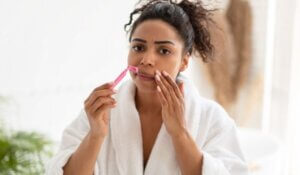
Fast forward to my teenage years, and the image that haunted me wasn’t Nana’s determined plucking but a short documentary I had watched about the life of “The Bearded Lady” in the traveling circus. Backlit by a spotlight, her chin boasted a thick, dark beard that seemed to mock my own emerging shadow on my upper lip. It was a time of intense self-consciousness, a feeling I know many can relate to when it comes to unwanted facial hair. But what causes this excess growth, and are there ways to manage it beyond desperate plucking under the bathroom light? Let’s explore the science behind facial hair in women, a condition known as hirsutism, and explore available treatment options.
It’s now accepted in most scientific circles that genetics plays the biggest role in determining whether a woman will start to grow facial hair as she ages. Some other causes besides aging are largely due to different hormonal changes, most notably polycystic ovary syndrome (PCOS) or rare disorders of the adrenal glands (Cushing’s syndrome or congenital adrenal hyperplasia). This dispels the idea that a woman can avoid the onset of facial hair growth by using magic creams and pastes when she is younger or by eating or avoiding certain foods. Unfortunately, for most of us, it’s in the genes. If there was a close relative somewhere in your family tree who developed hirsutism when they aged, the possibility that you will see the same thing happening is greatly elevated.
Why does hormone change result in hirsutism?
Most of us associate aging with hair loss rather than growth. In men, a receding hairline — androgenetic alopecia (AGA) — is a common feature that has a strong genetic element linked to slow reductions in testosterone levels (the male hormone). In women, the more dramatic drops in estrogen and progesterone levels that herald the onset of menopause are frequently accompanied by thinning of scalp hair. So the question that immediately pops up is how can a change that results in hair loss on one part of the head simultaneously cause new hair growth on the face?
It’s necessary to differentiate between terminal hair, which grows on the scalp, eyebrows, eyelashes, pubic areas, and chest, and vellus hair, the fuzzy, soft, and largely colorless hair that grows over the rest of the body. Hirsutism is a disorder that affects only terminal hair.
The role of androgens
Central to this issue are androgens, a group of hormones that includes testosterone. While typically linked to male characteristics and the reproductive cycle in women, both men and women have androgen hormones, but at different levels. Androgens also play a key role in controlling body hair growth.
Understanding the basics of hair structure and the hair growth cycle is crucial to understanding how any changes in hormones can cause concurrent thinning scalp hair and increased facial hair.
Hair anatomy
Each strand of hair comprises a shaft and an underlying root. The shaft is the visible part of the hair, while the root extends into layers beneath. Enclosed within a hair follicle, which consists of skin and connective tissue, the root is also connected to a sebaceous gland.
At the base of each hair strand lies a rounded bulb where the root widens. Within this bulb are the hair papilla, which supplies nutrients through blood flow to support hair growth. New cells continuously form at the base, near the papilla, gradually pushing up cells as they harden and stick together along the length of the strand. These cells subsequently become firm and as the hardened cells accumulate beneath it, it propels the strand upwards through the skin layers.
Understanding the hair growth cycle
Hair growth happens in three stages:
- Anagen (growth phase) — when hair follicles are actively growing, with cells dividing to boost the hair shaft. About 90% of terminal hair is usually in the growth phase.
- Catagen (transitional phase) — occurs at the end of the growth phase, when follicles shrink and separate from the dermis (the soft layer of cells immediately below the outer epidermis). This separates the root from the blood supply.
- Telogen (resting phase) — hair ceases growing, and the root is pushed out through the outer layers of the skin, leading to shedding.
Different parts of the body have follicles in stages simultaneously influenced by hormones, among other factors.
What do hormone changes do to hair follicles?
Depending on their location, hair follicles react differently to an increase in androgens.
Scalp
Hair follicles on the scalp are sensitive to dihydrotestosterone (DHT), a ‘hyperactive’ form of testosterone. Higher levels of DHT can cause these follicles to shrink through a process called miniaturization. This results in shorter, finer hair strands developing over time, eventually leading to hair thinning or bald patches (alopecia).
Face and Body
Hair follicles on the body and face respond differently to androgens by promoting hair growth. Increased androgen levels encourage these follicles to enter the anagen phase, resulting in the growth of terminal hairs. This is why women with elevated androgen levels due to conditions like polycystic ovary syndrome (PCOS) may notice increased hair growth on the face, pubis, and even on the chest.
While DHT negatively impacts scalp follicle size and health, leading to thinning hair strands, facial hair follicles respond to androgens by boosting growth activity, leading to hirsutism.
What are the main factors causing hirsutism?
Genes — hirsutism is a polygenic trait that isn’t attributable to a single gene. This means it is difficult to predict who will develop hirsutism solely based on family history, but there is a higher risk if there is a family history of hirsutism. One variant influences how hair follicles respond to androgens. It can make hair follicles more sensitive to androgens, leading to thicker, darker hair growth in areas where women typically do not have significant hair growth. A different gene influences how effectively the body converts testosterone into the more potent dihydrotestosterone (DHT), influencing both male pattern baldness and female hirsutism.
Polycystic ovarian syndrome (PCOS) — results in excess androgen production, disrupting hair growth cycles.
Menopause — the hormone changes during menopause can also alter androgen levels, affecting both scalp hair thinning and increased facial hair.
Medications — some drugs, such as anabolic steroids and hormone replacement therapies, boost androgen levels.
Adrenal gland disorders — Cushing’s syndrome and other adrenal disorders can lead to excess androgen production.
Treating hirsutism
Hirsutism is a recurrent and chronic condition requiring continuous attention. Common non-therapeutic methods, such as plucking, laser hair removal, electrolysis, and depilatory creams, temporarily improve a woman’s appearance, but the hair will almost always grow back quickly.
Doctors typically prescribe medications that slow down the rate of hair growth. This doesn’t completely stop or cure the problem of hirsutism but makes a person less reliant on physical treatments, which are often painful, can be expensive, and in some cases carry a risk of skin damage.
The pharmacological approach addresses the hormonal imbalance by specific routes, including:
- Anti-androgen medications like Aldactone can lower androgen levels and lessen hair growth. They take at least six months to work and do not have a particularly good success rate.
- Vaniqa is the first FDA-approved drug for treating hirsutism in women. It contains the active substance eflornithine, which slows down hair growth by affecting a protein essential in hair production. Vaniqa is not a depilatory and requires the continuation of some hair removal techniques but at a far lower frequency.
- Hormonal birth control pills that contain both estrogen and progestin (called combined birth control pills) are the recommended treatment for women diagnosed with polycystic ovary syndrome (PCOS). Birth control pills containing the progestin desogestrel (Cerazette, Mircette) can reduce excess hair growth and acne better than other pills.
- Doctors have several options when it comes to using Hormone Replacement Therapy to treat menopausal women who have also developed hirsutism. The specific treatment depends on the woman’s hormone levels (measuring estrogen, progesterone, testosterone, and others), so it needs to be evaluated on a case-by-case basis.
Frequently asked questions about hirsutism
How do dermatologists treat hirsutism?
It is essential to first identify the cause of the excessive hair growth. Once the underlying cause is determined, there may be a call for further tests and examinations. Prescribing a definitive course of treatment depends on the specifics of each case.
Can you get Vaniqa on prescription?
Yes. Vaniqa is specifically designed to reduce the excess growth of facial hair (hirsutism). It needs to be used for at least six months, along with the usual forms of hair removal besides waxing, shaving or depilatory creams. Results will only begin to show after 6–8 weeks.
Do you have to use Vaniqa forever to fight hirsutism?
Hirsutism cannot be cured. As long as Vaniqa is producing good results, by slowing down the rate of facial hair growth, it can be used indefinitely.
What pills stop hair growth on the face?
Eflornithine is used to slow the growth of unwanted hair on the face in women, usually around the lips or under the chin. It works by blocking a natural substance that is needed for hair to grow and is located in your hair follicle (the sac where each hair grows).
Does estrogen HRT reduce facial hair?
Hormone replacement therapy for menopausal women requires a combination of estrogen and progesterone to reduce the risk of breast cancer, and this has been seen to reduce both facial and body hair growth. Another option is to combine estrogen with anti-androgens (such as Aldactone).
















